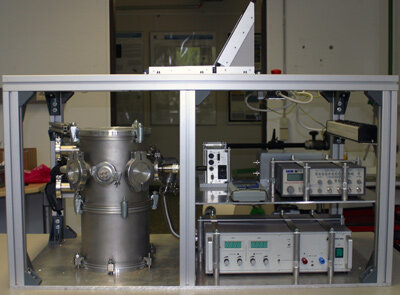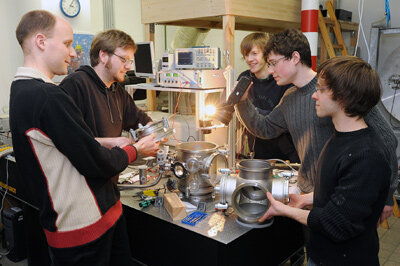Meet the teams
Four teams of postgraduate students flew their experiments during the 'Fly Your Thesis!' 2009 campaign. Here is an introduction to the German team.
![]()
Dust Side of the Force - The importance of the temperature gradient effect in planet formation processes and dust devils or storms on Mars![]()
![]()
| University | Institute of Planetology at the University of Münster, Germany |
| Endorsing professor |
Prof. Dr. Gerhard Wurm Faculty of Physics, University of Duisburg-Essen |
| Team |
Thorben Kelling Jens Teiser Markus Tegeder Tim Jankowski Matthias Lischper |

The Dust Side of the Force is a team of five students from the Institute of Planetology at the University of Münster, Germany. The aim of their experiment was to investigate the force induced by a temperature gradient in dust beds, which is thought to be important in planet formation and the formation of dust storms on Mars.
The effect occurs when a force resulting from a temperature gradient established in a gaseous medium is able to move particles or lift them off the ground in conditions of low gravity. For example, particles are ejected from a dust bed if the latter is illuminated and in a low pressure, gaseous environment. The illumination establishes a temperature gradient within the dust bed, which causes the dust to rise if the gas pressure measures only a few millibars.
The process that enables dust to be lifted even at high altitudes on Mars remains uncertain. However, this lifting effect might be the trigger for dust devils and/or dust storms on the red planet, since the atmospheric pressure of only 1-10 mbar should enable the forces induced by the temperature gradient to influence the dust particles very efficiently.
The effect may also apply in protoplanetary disks, where planets form through adhesion of dust and accretion. Drifting, dusty bodies near the central star might be eroded through extensive dust ejection due to a temperature gradient effect caused by intense stellar radiation. This may re-inject dust particles for planet formation into the disc instead of them being accreted by their host star. In both cases, the gravitational dependency of the lifting forces must be known to estimate how strong the effect is.

The experiment comprised an evacuated vacuum chamber in which a sample of simulated Martian soil was placed and then illuminated by a high power halogen lamp. The induced dust particle ejections were observed and recorded during microgravity, 1 g and 2 g conditions. The gravitational dependency of the ejection forces was then reconstructed.
The experiment worked successfully during all the parabola phases and provided the student team with a large amount of videos to be analysed.
The research has relevance to understanding the deposition of dust into the Martian atmosphere and in protoplanetary disks, such as the solar nebula from which the Earth and other planets formed about 4.5 billion years ago.
Read more about this experiment on the ERASMUS Experiment Archive.



